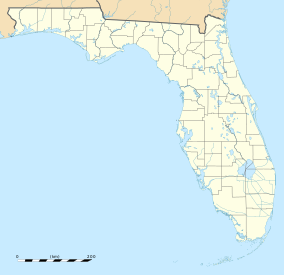Oscar Scherer State Park
| Oscar Scherer State Park | |
|---|---|
|
IUCN category V (protected landscape/seascape)
|
|
| Location | Sarasota County, Florida, USA |
| Nearest city | Sarasota, Florida |
| Coordinates | 27°10′30″N 82°27′58″W / 27.17500°N 82.46611°WCoordinates: 27°10′30″N 82°27′58″W / 27.17500°N 82.46611°W |
| Area | 1,400 acres (5.7 km2) |
| Established | 1956 |
| Governing body | Florida Department of Environmental Protection |
Oscar Scherer State Park is a Florida State Park located between Sarasota and Venice, near Osprey, amidst the heavily developed southwest Florida coast. The address is 1843 South Tamiami Trail. There are more than 130,000 visitors a year.
The park's genesis was in 1955, when Elsa Scherer Burrows, owner of the 462-acre (1.87 km2) South Creek Ranch, died. Her will left the ranch to the state to form a park. It was to be dedicated to the memory of her father, Oscar Scherer, the developer of a shoe leather dyeing process in 1872. A year later, the park was ready and opened to visitors.
Thirty years after that, realtor and environmentalist Jon Thaxton started work to protect the neighboring Florida scrub jay territory. In 1992 this resulted in 922 acres (3.73 km2) being added from the adjacent Palmer Ranch that had been among the holdings of Bertha Honoré Palmer, in large part due to the Nature Conservancy, public support, and the use of Preservation 2000 funds, expanding the park's size to 1,384 acres (5.60 km2).
In September 2008, in recognition of National Public Lands Day, Lee Wetherington, a local developer and long-time park supporter, donated an additional 16.6 acres (0.067 km2) of land to the park, including the buffer property adjacent to the Willowbend subdivision (a Wetherington development), bringing the total park size to 1,400 acres (5.7 km2).
The habitats that are part of the park are pine flatwoods, scrubby flatwoods and the hardwood hammock surrounding South Creek. A variety of other plants exist within the park, like blueberry, persimmon, wild grape, cabbage palm, coontie, wax myrtle, prickly pear cacti, mangrove trees and giant leather ferns (Acrostichum danaeifolium).
...
Wikipedia

